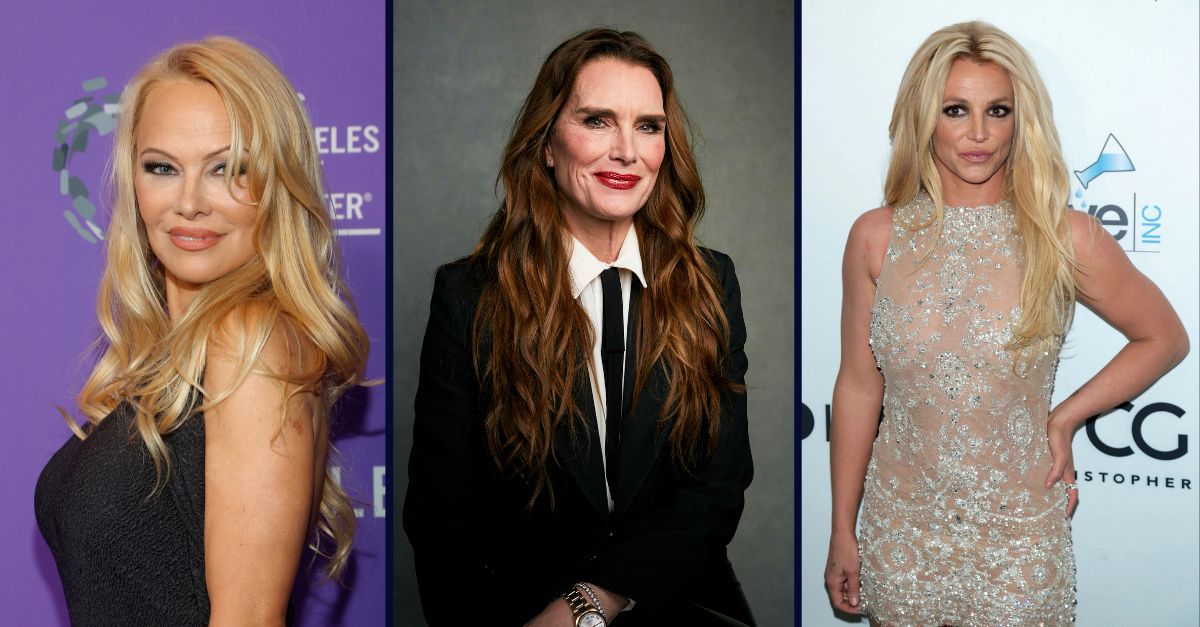
Left: LOS ANGELES, CA – APRIL 22: Pamela Anderson at the Los Angeles LGBT Center Gala 2023 at Fairmont Century Plaza in Los Angeles, California on April 22, 2023. Credit: Faye Sadou/MediaPunch /IPX. Center: FILE – Brooke Shields poses for a portrait to promote the film “Pretty Baby: Brooke Shields” at the Latinx House during the Sundance Film Festival on Jan. 21, 2023, in Park City, Utah. (Photo by Taylor Jewell/Invision/AP). Right: File Photo by: zz/GOTPAP/STAR MAX/IPx 2018 2/25/18 Britney Spears at the 4th Annual Hollywood Beauty Awards held on February 25, 2018 in Los Angeles, California.
“It makes no sense. The laws need to change.”
Those were the words spoken by Britney Spears at a 2021 hearing to protest the conservatorship she had been held in against her wishes, for over a decade.
These past few months, and even in the preceding years, we as a society have seen how the media has examined and revisited the way women central to pop culture in the 1990s and early aughts have been discussed, portrayed, and even treated. Just a few weeks ago, the documentaries “Pamela, A Love Story” and “Pretty Baby: Brooke Shields,” trailing the lives of Pamela Anderson and Brooke Shields, received several Emmy nominations, including for outstanding documentary or nonfiction special. In 2021, the trials and tribulations of Monica Lewinsky and Britney Spears were covered in the dramatic shows “American Crime Story: Impeachment” and the New York Times documentary “Framing Britney Spears,” respectively. In the year before that, the feature “Miss Americana,” focusing on Taylor Swift’s career after she had spent several years intentionally away from the public eye after severe media scrutiny, debuted to rave reviews.
Retracing the difficulties many of these women faced in decades prior not only brought them back into the spotlight, but it forced us as a whole to reexamine the way they were treated by the public. Attacks they and others in similar positions to them included widespread “slut-shaming,” invasion of privacy issues, public mockery, and sexual assault, to name a few. In the past few years, we have seen how younger generations have sought to analyze and even course-correct the way many female public figures were treated in societal terms, but it has not been examined as much in the context of the law.
Many of these women (and others like them) encountered difficulties and either attempted to utilize the law to advocate for themselves, and while some were successful — Taylor Swift’s victory in her 2017 sexual assault case, for example — others experienced the legal system working directly against them. Pamela Anderson was unable to prevent the release of her sex tape, and Britney Spears was stuck in a restrictive conservatorship for over a decade, against her well-documented wishes, until successfully terminating the arrangement in 2021. The release of these documentaries has reignited public conversation about how far we’ve come — and in some ways, still have to go — when it comes to how the public treats women, being reflected, as the New York Times describes, in a “surge of works that aim, in part, to reclaim the lives and narratives of maligned women of the recent past.”
Yet while the entertainment industry, public figures, and society in general are all supporting this initiative to revisit and restructure these narratives within the realm of media and pop culture, more remains to be done in terms of how the legal world can learn from these difficult moments. By examining how the law failed some of these women, perhaps we can better implement legal mechanisms that can afford greater protection in the future.
Pamela Anderson: How laws are fighting against “revenge porn” and unconsented release of sexual content
In the 1990s, Pamela Anderson became not only a key part of pop culture, but a slice of Americana: After modeling stints and various television roles, she gained national and even global recognition as a main cast member of iconic series “Baywatch.” Then, in 1995 — when the internet was still in its relative infancy — a sex tape of Anderson with her then-husband, drummer Tommy Lee, was stolen and leaked. Lee and Anderson both sued Internet Entertainment Group (IEG), which obtained the tape and sold it online, and years later were awarded default judgments after IEG failed to appear in court. Yet the couple was unable to obtain an injunction or any other form of relief to stop the images contained on the tape from spreading, with many judges and legal experts stating that because there was no charge to view the tape, it was commentary protected by the First Amendment. Moreover, the 2022 Hulu series “Pam and Tommy” also detailed the brutal effects of another legal battle for Anderson — she and Lee also sued Penthouse magazine founder Bob Guccione in 1996 after he had acquired copies of the tape and published photo images of it in his magazine. By 1997, a judge had tossed out their case and the couple decided to settle the suit against IEG. Anderson stated the couple had agreed to allow a one-time webcast, provided the company did not sell, copy, or rebroadcast it and believed they scored a victory, yet very few individuals then apparently knew the power of how videos and content would live online for decades.
The Hulu series “Pam and Tommy” — which Anderson states did not have her blessing — and Anderson’s own documentary “Pamela, a Love Story” shifts the narrative into her own viewpoint. The documentary achieves its goal of enabling Anderson to tell her own story and be awarded some long overdue respect from the public, but it begs the question: If this were to happen to a young female star today, how would she fare? Have the laws improved in the decades since?
Nowadays, videos of sexual content that are released without the participant’s consent are usually seen as “revenge porn,” which has now largely been outlawed throughout America. While revenge porn is usually when a former romantic partner uses such video or content and displays it publicly to humiliate or blackmail their counterpart, Anderson’s dilemma was slightly different, as it was content stolen by a third party. Now, such scenarios are typically protected and adjudicated through various laws prohibiting sextortion or blackmail. Specifically, in New York, laws prohibiting unlawful dissemination or publication of intimate images prevent individuals from such conduct, and even public figures need to provide consent for well-known companies to release such content legally. Numerous jurisdictions now recognize the tort of invasion of privacy and “most states have passed specific laws protecting a person’s ‘right of publicity,’ meaning their right to control and license their image for commercial purposes.”
Despite such progress, however, the growth of the internet and now social media has made enforcing legal safeguards even tougher, and it is certain the legal community will continue to work towards developing even more laws to prevent actions like what Anderson had to endure.
Brooke Shields: Reigniting the conversation on legal safeguards against on-screen nudity for young actors
Read Related Also: Police launch criminal probe after human placenta discovered in a city centre park
While many people of this current generation know who Brooke Shields is, it is safe to say very few millennials and members of Gen Z know the context of her rise to fame. In the Hulu documentary “Pretty Baby: Brooke Shields,” which debuted in April of this year (just a few months after Anderson’s doc), viewers get an in-depth look at Shields, her controversial upbringing by her manager mother, and the 1978 film that propelled her to fame, “Pretty Baby,” in which she portrayed a 12-year-old girl being raised in a brothel. Shields, who was 11 years old at the time of filming, appears nude in the movie, and while the movie was deemed controversial even at the time of the release, renewed attention due to the documentary has sparked outrage. Many began wondering how it was even legally possible to show a nude child in a major motion picture and why there were no legal safeguards in place to protect Shields at the time.
In the many years since, it is clear that laws have strengthened in terms of non-consensual nudity, whether onscreen or off. “Revenge porn,” a phrase that has only emerged in the past decade, is essentially a term referring to nonconsensual pornography, when a sexually graphic image, video, or any other form of content of an individual is shared without their consent. It has now been deemed illegal in nearly every state, including Texas, Florida, and California, and in New York, the act is punishable by up to one year in jail and a fine of up to $1,000 in criminal court. By March 2022, Congress passed a law enabling an individual to file a federal lawsuit against someone who has disclosed intimate images without the person’s consent. Further, numerous states also strengthened what has been deemed “Peeping Tom” laws, which essentially bars the use of cameras or video recording devices in private rooms such as dressing rooms or individuals filming or photographing others in states of undress without their consent. Finally, even sending unsolicited nude photos of oneself has been deemed a misdemeanor in some states, including California.
But while it is clear that laws regarding non-consensual nudity have strengthened over the years, the legal lines regarding nudity in the context of the arts or film is more blurred. In the 1960s and 1970s, as cinema was becoming more daring and experimental than the more rigid features of the 1950s, the film industry saw more and more actors, even underage, becoming prey to on-screen nudity. Just this past January, the actors who played the title roles in the 1968 film “Romeo and Juliet” — themselves just 16 and 15 years old at the time of filming — sued Paramount Pictures for filming them in the nude, only to have the case thrown out months after.
As of now, most if not all films do not feature nude minors, partially because of the legal issues that could arise as a result, but also as a way to avoid invoking any public ire. In 1986, the case United States v. Dost set out various factors used to determine if certain material qualified as child pornography, and if it did, then it cannot be shown in the film in question. Reviewing the film “Pretty Baby” and Shields’ shocking underage nudity within this new lens is sure to present shock, both because federal laws would not allow the nudity of a child to be displayed in a sexualized way, but also because society would not enable it. Indeed, even the phrase “child pornography” is starting to become a thing of the past, with the U.S. Department of Justice stating that the term “child sexual abuse material” is now used, as it more aptly “reflects the abuse that is depicted in the images and videos and the resulting trauma to the child.”
Shields herself opined in the documentary that while at the time she (and society) did not have the foresight to anticipate the outrage “Pretty Baby” would cause, she notes that many mechanisms in our world now would never allow it to exist today, stating: “There is nothing in my mind that had any idea that I would become the subject of so much controversy, conversation, vitriol… you couldn’t make a Pretty Baby now.”
Britney Spears: The large reform on conservatorship and guardianships
While Shields began to dominate pop culture in the 1970s and 1980s and Anderson catapulted to fame in the early 1990s, it can be argued Britney Spears capped off the end of the decade with a meteoric rise to fame. Her hit single “Baby One More Time” was released in the fall of 1998, and by the end of 1999, she became a household name. For years her success seemed never ending, until she suffered a mental breakdown in 2007 and was placed under a conservatorship in 2008. By February 2008, her father began to take charge of her affairs and became the conservator of both her individually and her estate, dictating everything from how much money she could spend, how often and where she worked, and even what color she could paint her kitchen cabinets.
Yet just mere months after being placed on a psychiatric hold and being deemed unable to care for herself, Spears was starring in a major television show, recording an album, and embarking on a world tour. This workload continued for over a decade, with Spears’ pleas to terminate the conservatorship and even be able to hire legal counsel of her own choosing being continuously denied. In November 2021, after a very public campaign by her fans deemed #FreeBritney, Spears was released from the conservatorship by a Los Angeles court, with Judge Brenda Penny deeming the arrangement “no longer required.” Both before and after the conservatorship’s end, numerous documentaries began to surface regarding Spears and specifically the legal arrangement which had dictated her life for so many years, including the 2021 New York Times documentaries, “Framing Britney Spears” and “Controlling Britney Spears,” as well as the Netflix special “Britney vs. Spears”, which was released in the same year. The documentaries detailed the ins and outs of Spears’ career, but particularly her struggles throughout the conservatorship. Many reported that the conservatorship began out of a serious concern for Spears’ mental health, yet slowly began infiltrating each part of her life, stripping her rights away in what many have deemed an “underregulated part of the legal system.”
In 2008, when the conservatorship was first implemented, the entire process was reported to have taken ten minutes, with zero testimony from any witnesses, no open questions asked by the presiding Judge Reva Goetz, who has since retired, or anyone speaking to or assessing Spears and her mental state. That remained in effect for over a decade, with many legal experts opining that the difficulty in challenging such an arrangement is due to the lack of precedent in this very niche area of the law. Typically, conservatorships are implemented for the extremely elderly, disabled, or mentally ill, with fewer stringent arrangements made for those with less serious ailments, such as a power of attorney or a trust with various restrictions. Such is the reason why many legal experts began wondering more publicly in 2021 why Spears, who during her conservatorship released four albums, embarked on numerous tours, and performed in a Las Vegas residency for four years, had been placed under such an intensive legal mechanism.
Spears was freed from these parameters just a few years ago, and massive efforts have been made to overhaul the entire system since. In New Jersey, courts narrowed down the group of people who could petition for their loved one to be placed under a guardianship, while New Mexico implemented a review process to oversee how conservatorships were being handled, and Oregon set requirements in place for anyone placed under a conservatorship to get free legal aid. Further, in May 2023, a bill called Karilyn’s Law was introduced in New York that would require a judge to hold a hearing within 10 days of someone filing an application to challenge a conservatorship. These efforts have even crossed the federal arena, with Congress introducing the legislation Guardianship Bill of Rights Act, which requires anyone being considered for a conservatorship to try less restrictive alternatives, have an attorney advocating on their behalf, and calling for timely review of the arrangement. The reactions and efforts to overhaul conservatorship laws has been swift, and it is certain many experts in this nuanced area of the law will be watching.
The legal landscape ahead
Thanks to social media, the changing views of the press, and numerous documentary features, the treatment of women who dominated the 1990s and early aughts has been brought to the forefront of public conversation. And while it is clear that efforts are being made to implement laws to afford the protection absent in prior years, it is also clear to many legal experts that more needs to be done. The law and media have always had a symbiotic relationship, and one needs the other in order to thrive. As such, it is clear that while lawmakers, policy changers, and attorneys fight to cement these changes into law, the mass media, press, and the public alike will be sure to cover every moment.
Have a tip we should know? [email protected]







